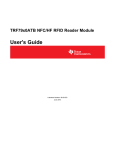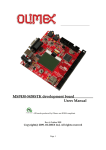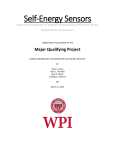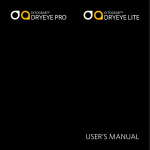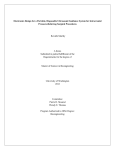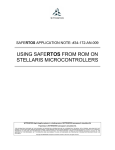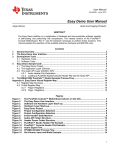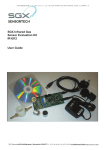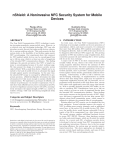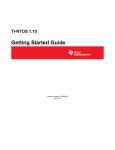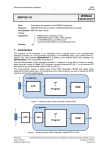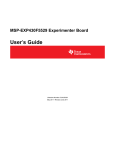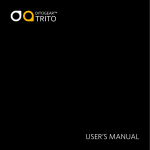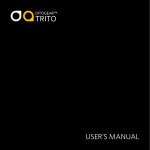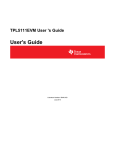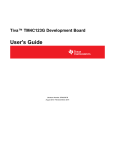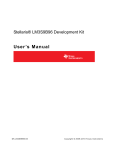Download TRF79x0ATB NFC/HF RFID Reader Module
Transcript
TRF79x0ATB NFC/HF RFID Reader Module User's Guide Literature Number: SLOU372A June 2013 – Revised June 2014 Contents 1 2 3 4 5 6 7 8 9 10 11 12 TRF79x0ATB Module Descriptions ......................................................................................... 5 TRF79x0ATB Connections and Technical Details ..................................................................... 6 TRF79x0ATB Module Schematic ............................................................................................ 8 MSP-EXP430F5529 Experimenters Board .............................................................................. 11 LM4F232 Evaluation Kit (EK-LM4F232) .................................................................................. 12 DK-LM3S9B96-EM2-TRF7960R ARM Cortex M-3 Development Board ........................................ 13 Quick Start ........................................................................................................................ 14 Base Application Firmware .................................................................................................. 14 Mechanical and Physical Information.................................................................................... 15 Antenna Tuning Details ....................................................................................................... 15 TRF79x0ATB Module Read Ranges ...................................................................................... 19 References ........................................................................................................................ 20 Revision History .......................................................................................................................... 21 2 Table of Contents SLOU372A – June 2013 – Revised June 2014 Submit Documentation Feedback Copyright © 2013–2014, Texas Instruments Incorporated www.ti.com List of Figures 1 TRF7960ATB Evaluation Module .......................................................................................... 5 2 TRF7970ATB Evaluation Module .......................................................................................... 6 3 TRF79x0ATB Module Schematic .......................................................................................... 8 4 MSP-EXP430F5438 Development Board ................................................................................ 9 5 Debug Header (RF3) Logic Analyzer Connections for Monitoring SPI Communications Between MSP430F5438A and TRF79x0A on TRF79x0ATB Module .......................................................... 10 6 Firmware Development and Debug Setup for MSP-EXP430F5438 Experimenters Board ....................... 10 7 MSP-EXP430F5529 Development Board ............................................................................... 11 8 MSP-EXP430F5539 RF EVM Header Pinouts (RF1 and RF2) ...................................................... 11 9 Debug Header (J12) Logic Analyzer Connections for Monitoring SPI Communications Between MSP430F5529 and TRF79x0A on TRF79x0ATB Module ............................................................ 12 10 EK-LM4F232 Development Platform (EM header locations on backside) .......................................... 12 11 DK-LM3S9B96-EM2-TRF7960R Development Platform .............................................................. 13 12 Theoretical Parallel Resistor Value for Desired Q ..................................................................... 17 13 Theoretical Capacitance Values for Resonance at Desired Q ....................................................... 17 List of Tables 1 Connector P1/RF1 ........................................................................................................... 6 2 Connector P2/RF2 ........................................................................................................... 7 SLOU372A – June 2013 – Revised June 2014 Submit Documentation Feedback List of Figures Copyright © 2013–2014, Texas Instruments Incorporated 3 User's Guide SLOU372A – June 2013 – Revised June 2014 TRF79x0ATB NFC/HF RFID Reader Module This evaluation module provides directions for TRF7960A and TRF7970A users to implement a 13.56MHz NFC/RFID reader solution using the TRF79x0A IC connected to a Texas Instruments embedded microcontroller or microprocessor development platform. Examples of such development platforms are: the MSP-EXP430F5438 board, MSP-EXP430F5529 board, the ARM® Cortex™-M3/M4-based board, or any other TI embedded microcontroller platforms with the EM socket headers populated. This document also covers the TRF79x0ATB module as it relates to using the module for evaluation and development purposes in conjunction with Texas Instruments Embedded Development platforms. It does not cover the in-depth details of the TRF79x0A NFC/RFID IC families, as those details are well documented in the data sheets for those parts, along with application reports that can be found on the product pages (see Section 12). FCC/IC Regulatory Compliance: • FCC – FEDERAL COMMUNICATIONS COMMISSION Part 15, Class A Compliant • IC – INDUSTRY CANADA Class A Compliant Tiva is a trademark of Texas Instruments. 4Stellaris,TRF79x0ATB RFID Reader Module SLOU372A – June 2013 – Revised June 2014 StellarisWareNFC/HF are registered trademarks of Texas Instruments. Submit Documentation Feedback Cortex is a trademark of ARM Limited. Copyright © 2013–2014, Texas Instruments Incorporated ARM is a registered trademark of ARM Limited. All other trademarks are the property of their respective owners. TRF79x0ATB Module Descriptions www.ti.com 1 TRF79x0ATB Module Descriptions The TRF79x0ATB evaluation modules are intended to allow the software application developer to get familiar with the functionalities of either of the TRF79x0A Multi-Standard Fully Integrated 13.56 MHz NFC/RFID reader ICs with the freedom to develop on their Texas Instruments Embedded microcontroller development platform of choice. The TRF79x0ATB module is also intended to allow customer driven antenna tuning with onboard coil and customer driven antenna form factor design. The module is hard wired for SPI communications, supports Slave Select and TRF79x0A Direct Mode 2 (default), Direct Mode 1 and Direct Mode 0 operations. The user also has access to and full control over the TRF79x0A EN2 and EN lines, allowing for design and development of ultra low power NFC/HF RFID systems. The module has an onboard boost converter (TPS61222DCKT) that boosts +3.3 VDC in to +5 VDC out to TRF79x0A IC for +23 dBm (full transmitter power out) operations. An impedance matching circuit from 4 Ω to 50 Ω is populated on the module and this is connected to a tuned 50 Ω antenna circuit, which consists of an onboard four turn coil with series and parallel passive elements (capacitors and a resistor). Test points are available on the board for checking firmware operations with the oscilloscope or logic analyzer, impedance matching and for attaching external antenna. Connection to Texas Instruments Microcontroller platforms are made via Samtec EM headers located on the underside of the board (Connectors P1/RF1 and P2/RF2). Figure 1. TRF7960ATB Evaluation Module SLOU372A – June 2013 – Revised June 2014 Submit Documentation Feedback TRF79x0ATB NFC/HF RFID Reader Module Copyright © 2013–2014, Texas Instruments Incorporated 5 TRF79x0ATB Connections and Technical Details www.ti.com Figure 2. TRF7970ATB Evaluation Module 2 TRF79x0ATB Connections and Technical Details Table 1. Connector P1/RF1 Pin No 6 Signal Name Description 1 GND Ground 2 N/C 3 MOD 4 N/C 5 N/C 6 N/C 7 IRQ 8 N/C 9 SYS_CLK Clock for MCU (optional) If EN = 0 and EN2 = 1, then system clock is set to 60 kHz 10 EN Chip enable input (If EN = 0, then chip is in power-down mode). 11 N/C 12 EN2 13 N/C 14 SLAVE SELECT 15 N/C 16 DATA_CLK 17 N/C 18 MOSI I/O_7, Master Out, Slave In (Data In from MCU) 19 GND Ground 20 MISO I/O_6, Master In, Slave Out (Data Out from TRF7960) Direct mode, external modulation input Interrupt request (from TRF79x0A to MCU) Pulse enable and selection of power down mode. If EN2 is connected to VIN, then VDD_X is active during power down to support the MCU. Pin can also be used for pulse wake-up from power-down mode. Slave Select, I/O_4 (Active Low) Data Clock Input for MCU Communication (from MCU) TRF79x0ATB NFC/HF RFID Reader Module Copyright © 2013–2014, Texas Instruments Incorporated SLOU372A – June 2013 – Revised June 2014 Submit Documentation Feedback TRF79x0ATB Connections and Technical Details www.ti.com Table 2. Connector P2/RF2 Pin No Signal Name 1 N/C 2 N/C 3 N/C 4 N/C 5 N/C 6 N/C 7 +3.3VDC IN 8 N/C 9 +3.3VDC IN 10 N/C 11 N/C 12 N/C 13 N/C 14 N/C 15 N/C 16 N/C 17 N/C 18 ASK/OOK 19 N/C 20 N/C SLOU372A – June 2013 – Revised June 2014 Submit Documentation Feedback Description +VDC in (to TPS61222DCKT for generation of +5 VDC) +VDC in (to TPS61222DCKT for generation of +5 VDC) Direct mode, selection between ASK and OOK modulation (0 = ASK, 1 = OOK) Also can be configured to provide the received analog signal output (ANA_OUT) TRF79x0ATB NFC/HF RFID Reader Module Copyright © 2013–2014, Texas Instruments Incorporated 7 TRF79x0ATB Module Schematic 3 www.ti.com TRF79x0ATB Module Schematic A This schematic drives two separate layouts. (TRF7960ATB.brd and TRF7970ATB.brd) the only difference is the bottom side silkscreen. Figure 3. TRF79x0ATB Module Schematic 8 TRF79x0ATB NFC/HF RFID Reader Module Copyright © 2013–2014, Texas Instruments Incorporated SLOU372A – June 2013 – Revised June 2014 Submit Documentation Feedback TRF79x0ATB Module Schematic www.ti.com MSP-EXP430F5438 Experimenters Board The MSP430F5438 Experimenter Board (MSP-EXP430F5438) is a development platform for the latest generation MSP430 MCUs. It features a 100-pin socket that supports the MSP430F5438 data sheet and other devices with similar pinouts. The socket allows for quick upgrades to newer devices or quick applications changes. It is also compatible with many TI low-power RF wireless evaluation modules such as the CC2520EMK and the TRF79x0ATB module discussed in this document. The Experimenter Board helps designers quickly learn and develop using the new F5xx MCUs, which provide the industry’s lowest active power consumption, more memory and leading integration for applications such as energy harvesting, wireless sensing and automatic metering infrastructure (AMI). A TI Flash Emulation Tool, like the MSP-FET430UIF, is required to program and debug the MSP430 devices on the experimenter board. Rf3 Debug Header TRF79x0ATB module connects here Figure 4. MSP-EXP430F5438 Development Board SLOU372A – June 2013 – Revised June 2014 Submit Documentation Feedback TRF79x0ATB NFC/HF RFID Reader Module Copyright © 2013–2014, Texas Instruments Incorporated 9 TRF79x0ATB Module Schematic www.ti.com Figure 5. Debug Header (RF3) Logic Analyzer Connections for Monitoring SPI Communications Between MSP430F5438A and TRF79x0A on TRF79x0ATB Module RF3 Debug Header Figure 6. Firmware Development and Debug Setup for MSP-EXP430F5438 Experimenters Board 10 TRF79x0ATB NFC/HF RFID Reader Module Copyright © 2013–2014, Texas Instruments Incorporated SLOU372A – June 2013 – Revised June 2014 Submit Documentation Feedback MSP-EXP430F5529 Experimenters Board www.ti.com 4 MSP-EXP430F5529 Experimenters Board The MSP430F5529 Experimenter Board (MSP-EXP430F5529) is a development platform for the MSP430F5529 device, from the latest generation of MSP430 devices with integrated USB. The board is compatible with many TI low-power RF wireless evaluation modules such as the TRF79xxATB modules. The Experimenter Board helps designers quickly learn and develop using the new F55xx MCUs, which provide the industry's lowest active power consumption, integrated USB, and more memory and leading integration for applications such as NFC, HF RFID, energy harvesting, wireless sensing and automatic metering infrastructure (AMI). The MSP430F5529 device on the experimenter board can be powered and debugged via the integrated ezFET, or via TI Flash Emulation Tool, like the MSP-FET430UIF. The TRF79x0ATB module plugs into the RF1 and RF2 headers on this MSP-EXP board (see Figure 7 and Figure 8). For logic analyzer connection during firmware debug, user can use test points on TRF79x0ATB board or pins on header J12 (see Figure 9). TRF79 x0A TB module connects here Logic Analyzer and Debug Header J12 Firmware Download/Debug Header Figure 7. MSP-EXP430F5529 Development Board Figure 8. MSP-EXP430F5539 RF EVM Header Pinouts (RF1 and RF2) SLOU372A – June 2013 – Revised June 2014 Submit Documentation Feedback TRF79x0ATB NFC/HF RFID Reader Module Copyright © 2013–2014, Texas Instruments Incorporated 11 LM4F232 Evaluation Kit (EK-LM4F232) www.ti.com Figure 9. Debug Header (J12) Logic Analyzer Connections for Monitoring SPI Communications Between MSP430F5529 and TRF79x0A on TRF79x0ATB Module 5 LM4F232 Evaluation Kit (EK-LM4F232) The Tiva™ C Series LM4F232 USB+CAN Development Kit is a compact and versatile evaluation platform for the Tiva C series TM4C123GH6PGE ARM Cortex-M4F-based microcontroller. The evaluation kit design highlights the TM4C123GH6PGE microcontroller integrated USB 2.0 On-the-Go/Host/Device interface, CAN, analog, and low-power capabilities. The evaluation kit features the TM4C123GH6PGE microcontroller in a 144-LQFP package, a color OLED display, USB OTG connector, a microSD card slot, a coin cell battery for use with the Tiva C Series lowpower Hibernate mode, a temperature sensor, a three-axis accelerometer for motion detection, and easy access through holes to all of the available device signals. The kit also includes extensive source code examples, allowing you to start building C code applications quickly. Figure 10. EK-LM4F232 Development Platform (EM header locations on backside) 12 TRF79x0ATB NFC/HF RFID Reader Module Copyright © 2013–2014, Texas Instruments Incorporated SLOU372A – June 2013 – Revised June 2014 Submit Documentation Feedback DK-LM3S9B96-EM2-TRF7960R ARM Cortex M-3 Development Board www.ti.com 6 DK-LM3S9B96-EM2-TRF7960R ARM Cortex M-3 Development Board The Stellaris® DK-LM3S9B96-EM2-TRF7960R Development Kit provides a feature-rich development platform for Ethernet, USB OTG/Host/Device, and CAN enabled Stellaris ARM Cortex-M3-based microcontrollers. Each board has an In-Circuit Debug Interface (ICDI) that provides hardware debugging functionality not only for the on-board Stellaris devices, but also for any Stellaris microcontroller-based target board. The development kit contains all cables, software, and documentation needed to develop and run applications for Stellaris microcontrollers easily and quickly. The Stellaris DK-LM3S9B96-EM2TRF7960R Development Kit features: StellarisWare® Peripheral Library, USB Library, and Graphics Library in conjunction with ARM development tools from ARM tools partners. An EPI header to EM header interface board (DK-LM3S9B96-EM2) is needed for use with the TRF7960TB module. Figure 11. DK-LM3S9B96-EM2-TRF7960R Development Platform SLOU372A – June 2013 – Revised June 2014 Submit Documentation Feedback TRF79x0ATB NFC/HF RFID Reader Module Copyright © 2013–2014, Texas Instruments Incorporated 13 Quick Start 7 www.ti.com Quick Start 1. Plug TRF79x0ATB Module into microcontroller development platform of choice. NOTE: If DK-LM3S9B96 board, remove SDRAM module and replace with DK-LM3S9B96-EM2 interface board before attempting to mount TRF79x0ATB module. 2. 3. 4. 5. 6. 8 Apply power. Load the base application firmware specific to the platform that you are working with. Test for basic communication and functionality. Modify and Debug code as desired for specific application or protocol. Test for advanced functionality as implemented by modified code. Base Application Firmware TRF79x0ATB module base application firmware for various Texas Instruments Microcontrollers are available here: • MSP430F23xx: http://www.ti.com/litv/zip/sloc203 (Code Composer Studio or IAR) • MSP430F5438A: http://focus.ti.com/docs/toolsw/folders/print/msp-exp430f5438.html • MSP430F5529: http://www.ti.com/tool/nfclink • LM4F232: http://www.ti.com/tool/ekc-lm4f232 • LM3S9B96: http://www.ti.com/tool/dk-em2-7960r 14 TRF79x0ATB NFC/HF RFID Reader Module Copyright © 2013–2014, Texas Instruments Incorporated SLOU372A – June 2013 – Revised June 2014 Submit Documentation Feedback Mechanical and Physical Information www.ti.com 9 Mechanical and Physical Information 10 Antenna Tuning Details Module antenna as shipped is tuned for 50 Ω impedance at 13.56 MHz. It has a nominal bandwidth of 1.3 MHz, which results in a quality factor of approximately 10. Module antenna circuit has a board mounted U.FL connector installed for users that want to experiment with different tuning solutions or disconnect onboard antenna and experiment with antennas of their own design or application. Below are some design and application notes for users to reference if they want to change the antenna Q factor or experiment further on their own in order to serve their particular application directly. TRF79x0ATB coil antenna tuning details starts with calculations to produce the theoretical values shown below (and based on measurements of antenna coil on Rev B board.) The coil value nominally measures 0.95 µH at 13.56 MHz and XL = 0.8 + j80.8 = 0.990 @ 63.4°. To calculate the necessary values required for course resonance tuning and proper Q setting of the antenna, the following formula is used. CRES(total ) = 1 w 2L (1) where w = 2p f SLOU372A – June 2013 – Revised June 2014 Submit Documentation Feedback TRF79x0ATB NFC/HF RFID Reader Module Copyright © 2013–2014, Texas Instruments Incorporated 15 Antenna Tuning Details www.ti.com therefore, CRES(total ) = 1 (2p ´ 13.56 MHz )2 ´ 0.95 m H CRES(total ) = 145.157 pF (2) The dampening resistor value can now be calculated for a desired Q value using the formula: Q= RPAR 2p fL (3) therefore, RPAR = 2p fLQ (4) For Q = ~20 (ISO15693 operations): RPAR = 1.29 k W (5) (move to standard value of 1.3 kΩ) For Q = ~10 (ISO14443 and ISO15693 operations): RPAR = 647 W (6) (move to standard value of 680 Ω) Smith Chart simulation for RPAR value = 1.3 kΩ reveals theoretical parallel and series capacitor values capacitor values to be 97pF and 51pF, respectively. (This is < +2% change from the calculated total cap value.) Smith Chart simulation for RPAR value = 680 Ω (standard value) reveals theoretical parallel and series capacitor values to be 82 pF and 69 pF, respectively. (This is < +4% change from the calculated value.) 16 TRF79x0ATB NFC/HF RFID Reader Module Copyright © 2013–2014, Texas Instruments Incorporated SLOU372A – June 2013 – Revised June 2014 Submit Documentation Feedback Antenna Tuning Details www.ti.com The calculations and simulations for a desired Q range of 5 to 20 results in Figure 12 and Figure 13 that indicate the required resistor and capacitance values should be populated. Theoretical Parallel Resistor Value for Desired Q 001.73E+03 001.53E+03 Ohms 001.33E+03 1.30E+03 001.13E+03 Rpar 925.00E+00 725.00E+00 680.71E+00 525.00E+00 325.00E+00 4 6 8 10 12 14 16 18 20 Q Value Figure 12. Theoretical Parallel Resistor Value for Desired Q Theoretical Capacitance Values for Resonance at Desired Q 97.00E-12 Capacitance (in pF) 102.00E-12 092.00E-12 82.00E-12 082.00E-12 072.00E-12 Cpar Cser 68.00E-12 062.00E-12 51.00E-12 052.00E-12 042.00E-12 4 6 8 10 12 14 16 18 20 Q Figure 13. Theoretical Capacitance Values for Resonance at Desired Q Actual measurements on TRF79x0ATB module for high and lower Q value tuning solutions. SLOU372A – June 2013 – Revised June 2014 Submit Documentation Feedback TRF79x0ATB NFC/HF RFID Reader Module Copyright © 2013–2014, Texas Instruments Incorporated 17 Antenna Tuning Details www.ti.com Higher Q Antenna Measurement Plots with Calculated Values (Q = ~20) Lower Q Antenna Measurement Plots with Calculated Values (Q = ~10) 18 TRF79x0ATB NFC/HF RFID Reader Module Copyright © 2013–2014, Texas Instruments Incorporated SLOU372A – June 2013 – Revised June 2014 Submit Documentation Feedback TRF79x0ATB Module Read Ranges www.ti.com 11 TRF79x0ATB Module Read Ranges SLOU372A – June 2013 – Revised June 2014 Submit Documentation Feedback TRF79x0ATB NFC/HF RFID Reader Module Copyright © 2013–2014, Texas Instruments Incorporated 19 References 12 References • • • • • • • • • • • • • • • • 20 www.ti.com TRF7960A Product Page: http://www.ti.com/product/trf7960A TRF7970A Product Page: http://www.ti.com/product/trf7970A TPS61222 Product Page: http://www.ti.com/product/tps61222 TRF7960ATB Schematic, BOM and Design files: http://www.ti.com/lit/zip/sloc221 TRF7970ATB Schematic, BOM and Design files: http://www.ti.com/lit/zip/tidc356 LM4F232 Evaluation Kit: http://www.ti.com/tool/ek-lm4f232 TPS61220, TPS61221,TPS61222 Low Input Voltage Step-Up Converter in 6 Pin SC-70 Package Data Sheet (SLVS776) MSP430F543x, MSP430F541x Mixed Signal Microcontroller Data Sheet (SLAS612) TRF7960A Multi-Protocol Fully Integrated 13.56-MHz RFID Reader/Writer IC Data Manual (SLOS732) TRF7970A Multi-Protocol Fully Integrated 13.56-MHz RFID/Near Field Communication (NFC) Transceiver IC Data Manual (SLOS743) MSP-EXP430F5529 Experimenter Board User's Guide (SLAU330) MSP-EXP430F5438 Experimenter Board User's Guide (SLAU263) Stellaris® LM3S9B96 Development Kit User's Manual (SPMA036) TI ISO15693/ISO18000-3 Inlays/Tags Parametric Search http://www.ti.com/lsds/ti/wireless_connectivity/nfc_rfid/products.page#o7=Transponders, Inlays and Dies Samtec Header and Mate Information – SFM: https://www.samtec.com/technical-specifications/Default.aspx?seriesMaster=SFM – TFM: https://www.samtec.com/technical-specifications/Default.aspx?seriesMaster=TFM Smith Chart Simulation Tool (licensed copy): http://www.fritz.dellsperger.net/ TRF79x0ATB NFC/HF RFID Reader Module Copyright © 2013–2014, Texas Instruments Incorporated SLOU372A – June 2013 – Revised June 2014 Submit Documentation Feedback Revision History www.ti.com Revision History Changes from Original (June 2013) to A Revision ......................................................................................................... Page • Corrected links in Section 12 ........................................................................................................... 20 NOTE: Page numbers for previous revisions may differ from page numbers in the current version. SLOU372A – June 2013 – Revised June 2014 Submit Documentation Feedback Revision History Copyright © 2013–2014, Texas Instruments Incorporated 21 IMPORTANT NOTICE Texas Instruments Incorporated and its subsidiaries (TI) reserve the right to make corrections, enhancements, improvements and other changes to its semiconductor products and services per JESD46, latest issue, and to discontinue any product or service per JESD48, latest issue. Buyers should obtain the latest relevant information before placing orders and should verify that such information is current and complete. All semiconductor products (also referred to herein as “components”) are sold subject to TI’s terms and conditions of sale supplied at the time of order acknowledgment. TI warrants performance of its components to the specifications applicable at the time of sale, in accordance with the warranty in TI’s terms and conditions of sale of semiconductor products. Testing and other quality control techniques are used to the extent TI deems necessary to support this warranty. Except where mandated by applicable law, testing of all parameters of each component is not necessarily performed. TI assumes no liability for applications assistance or the design of Buyers’ products. Buyers are responsible for their products and applications using TI components. To minimize the risks associated with Buyers’ products and applications, Buyers should provide adequate design and operating safeguards. TI does not warrant or represent that any license, either express or implied, is granted under any patent right, copyright, mask work right, or other intellectual property right relating to any combination, machine, or process in which TI components or services are used. Information published by TI regarding third-party products or services does not constitute a license to use such products or services or a warranty or endorsement thereof. Use of such information may require a license from a third party under the patents or other intellectual property of the third party, or a license from TI under the patents or other intellectual property of TI. Reproduction of significant portions of TI information in TI data books or data sheets is permissible only if reproduction is without alteration and is accompanied by all associated warranties, conditions, limitations, and notices. TI is not responsible or liable for such altered documentation. Information of third parties may be subject to additional restrictions. Resale of TI components or services with statements different from or beyond the parameters stated by TI for that component or service voids all express and any implied warranties for the associated TI component or service and is an unfair and deceptive business practice. TI is not responsible or liable for any such statements. Buyer acknowledges and agrees that it is solely responsible for compliance with all legal, regulatory and safety-related requirements concerning its products, and any use of TI components in its applications, notwithstanding any applications-related information or support that may be provided by TI. Buyer represents and agrees that it has all the necessary expertise to create and implement safeguards which anticipate dangerous consequences of failures, monitor failures and their consequences, lessen the likelihood of failures that might cause harm and take appropriate remedial actions. Buyer will fully indemnify TI and its representatives against any damages arising out of the use of any TI components in safety-critical applications. In some cases, TI components may be promoted specifically to facilitate safety-related applications. With such components, TI’s goal is to help enable customers to design and create their own end-product solutions that meet applicable functional safety standards and requirements. Nonetheless, such components are subject to these terms. No TI components are authorized for use in FDA Class III (or similar life-critical medical equipment) unless authorized officers of the parties have executed a special agreement specifically governing such use. Only those TI components which TI has specifically designated as military grade or “enhanced plastic” are designed and intended for use in military/aerospace applications or environments. Buyer acknowledges and agrees that any military or aerospace use of TI components which have not been so designated is solely at the Buyer's risk, and that Buyer is solely responsible for compliance with all legal and regulatory requirements in connection with such use. TI has specifically designated certain components as meeting ISO/TS16949 requirements, mainly for automotive use. In any case of use of non-designated products, TI will not be responsible for any failure to meet ISO/TS16949. Products Applications Audio www.ti.com/audio Automotive and Transportation www.ti.com/automotive Amplifiers amplifier.ti.com Communications and Telecom www.ti.com/communications Data Converters dataconverter.ti.com Computers and Peripherals www.ti.com/computers DLP® Products www.dlp.com Consumer Electronics www.ti.com/consumer-apps DSP dsp.ti.com Energy and Lighting www.ti.com/energy Clocks and Timers www.ti.com/clocks Industrial www.ti.com/industrial Interface interface.ti.com Medical www.ti.com/medical Logic logic.ti.com Security www.ti.com/security Power Mgmt power.ti.com Space, Avionics and Defense www.ti.com/space-avionics-defense Microcontrollers microcontroller.ti.com Video and Imaging www.ti.com/video RFID www.ti-rfid.com OMAP Applications Processors www.ti.com/omap TI E2E Community e2e.ti.com Wireless Connectivity www.ti.com/wirelessconnectivity Mailing Address: Texas Instruments, Post Office Box 655303, Dallas, Texas 75265 Copyright © 2014, Texas Instruments Incorporated






















